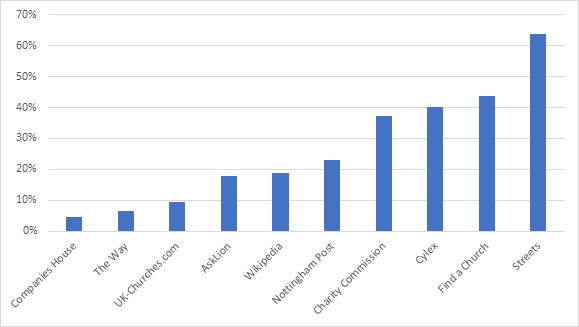
The internet is a useful starting point for finding community, but what gets missed? We know that community directories and webpages will never capture the subtleties of community groups and organisations, whether that means the warmth of the welcome or the unwritten rules of group culture. But does the universe of community life contain dark matter [1] that is unseen by the electronic eye? Is there more community out there than we can find by a brief search of the internet?
Searching for community
Back in 2011, Dr Andri Soteri-Proctor found many community assets and resources lying ‘below the radar’, unknown to larger organisations, regulatory bodies and statutory agencies. Has this changed now most people are computer literate? To investigate this question in early 2023, I selected one complex but focused area of community life – the Christian churches that meet regularly and in person in my city [2]. The first stage of the investigation consisted of a persistent search which identified 187 active churches and another 88 that were either closed (70), unresponsive (14), or that carried our all their operations online (4). Anyone searching online will find one closed or unresponsive church for every two active ones.
Noticeboard or gravestone?
I used a variety of online search tools. When trying to determine whether a listed church is currently active, the best tool is Wikipedia, since it explicitly lists some places as a ‘former church’ and gives the dates that the church began and ended its life. However, it found only 32 of the 187 active churches in the city, fewer than one in five.
One hundred and thirty of the active churches in the City (70%) maintained a website, but some of them omitted any reference to the year, leaving viewers questioning whether the information they contain is current. Indeed, websites can be found for some of the closed churches which masquerade as active noticeboards, but closer inspection reveals them to be gravestones, the enduring online legacy of a former church that is no longer open for public worship.
Thirty eight of our active churches had no Facebook page and 20 of them (11%) had no website either. It can be hard to find a specific Facebook page unless the organisation’s name, venue address and other identifying elements are already to hand. Such pages append the date to each entry and place the most recent uppermost, easing the process of checking whether the page is still in use. If there had been a Facebook entry or website evidence of activity in the last three months, or if a future date was mentioned, I judged this church to be active. Churches that failed these tests were emailed, texted, phoned or written to and those that responded were logged as active where appropriate.
Statutory registration might be expected to deliver more information, but that hope was short-lived. It turns out that only 34% of our active churches in the City are registered with the Charity Commission, so 63 appear on their database. The Companies House database found just 11 of the 187 active churches in the city.
Only some community activities are recognised
With 187 active churches in the City and a population of around 340,000, this averages at one church per 1,850 residents. Local Directories aim to capture the organisational and voluntary life of the community by creating an online and searchable index. Ours is called ASKLiON and it contained 2,091 entries on the day it was inspected in July 2023, but only 27 of the 187 active churches appeared (14%). ASKLiON would gladly post information about the remaining 160 churches, as well as information about all the religious and community-building activities of each church, rather than confining their submission to humanitarian activities, as is the case at present. The shortfall arises because the churches do not submit their data and not because it is filtered by ASKLiON, so we have to wonder how such a misunderstanding has arisen.
In all, 28 online listings were searched [3], revealing 11 active churches that figure in no online list at all while 25 appear on ten or more lists. Only a few active churches curate their internet profile as an integrated whole by providing links from one appearance to another and ensuring that all sites contain up to date information.
A little over half
If online searchers only knew it, they might turn to the one source that dominates all other specialist church directories across the UK. Find a Church gets three million listing views a year and it found 74 of our 187 active churches, less than half (40%) but far more than any other specialist national list. Just 21 churches had paid Find a Church a registration fee (£22 per year in 2023) to enable them to publish comprehensive information about their activities. Information regarding non-fee paying churches amounts to name and address, which may be the home of the secretary rather than the venue for public worship [3]. However, the name and address provides a starting point for further investigation.
This suggests that we should simplify our quest by seeking just the name and address of the church, rather than further details. Once we have these basic details, we can use other means to find out what we need to know – meeting times, Facebook pages and so forth.

At this point, all the specialist church directories are outshone by Streets, a database built from geographical information and perhaps by using artificial intelligence to scrape data from the internet. Within the city boundary, there are 187 open churches, and, while Find a Church located 74 of them (40%), Streets located 108 (59%). Both also found many false positives and so they both listed churches that are no longer open.
The exact numbers may change as churches open, merge and close, as better email addresses are discovered and busy administrators get around to responding to inquiries. However, there is no reason to think that overall proportions will shift more than a few percentage points.
Elusive yet active
In summary, a desk-based search of websites, search tools and Facebook followed by email and text messaging found one inactive church for every two active ones; use of a single search tool was unlikely to locate even half of the active churches and, in this field at least, generic databases deliver basic information about more community organisations than specialist ones. The considerable number of elusive yet active churches suggests that even more would be found by offline searching – walking around the neighbourhood, reading noticeboards and talking to people.
The entire Christian church in the city is complex, containing a mix of large and small organisations, a variety of accommodation arrangements and a diversity of cultural preferences. This means that a large institution such as the Church of England will have its own online listing of churches, but smaller groups may not. It means that historic organisations that have built their own places of worship will have to grapple with redundant buildings as congregations shrink or expand, while newer groups can rename themselves and migrate from community centre to church hall with ease and so remain elusive. It means that groups lacking computer skills carry out their whole communal life without recourse to Facebook, email or website. Most online listings appear to under-represent communities led by people of colour. For example, in July 2023, while a total of 28 organisations in Nottingham were providing Christian meetings led in a community language other than English, only 60% of them were known to a local infrastructure group and none appeared on ASKLiON.
Put on your coat
Across the city, the church is made up of multiple independent organisations and both its funding mechanism and its limited accountability to external bodies contribute to its low online visibility. Other sectors of community life that share this fragmented structure, such as arts organisations, are likely to be similarly difficult to find. If searchers remain curious about the community’s ‘dark matter’ they must eventually switch off their computer, put on their coat and set off to walk the neighbourhood and talk to people. As Jo Ward declared, “Any social prescriber relying on any one directory isn’t doing their job. They should be developing key personal relationships in localities and accessing multiple information sources simultaneously.”
Further resources on community mapping include:
- Bates P (2023) Detecting dark matter
- Bates P (2023) Introduction to community maps and directories
- Bates P (2023) How to meet your statutory obligations in community mapping
- Bates P (2023) How to choose between a community or service directory
- Bates P (2023) How to measure the reach of community directories
- Bates P (2023) How to decide what to put in your map of community assets
- Bates P (2023) How to get your group listed in community directories
- Bates P (2023) How to name your dragon – identifying the threats to community mapmaking
- Bates P (2023) Goldmining – how to find hidden community treasure
- Bates P (2023) List of SEND Local Offer websites
- Bates P (2023) Directory of directories
[1] Just to be clear – I am using the idea of dark matter from astrophysics to refer to community groups and organisations that are unseen when conducting a brief internet search. I am not making any reference to the dark web, where illegal or distasteful material can somehow be found online.
[2] The main venue for public worship was identified in each case and then its postcode checked. Those that fell within the areas served by Nottingham City Council were included in the count. There are many more churches based in neighbouring areas that are accessible to the residents of Nottingham.
[3] The search tools were: A church near you and the Southwell and Nottingham Church History Project ; AskLion; Assemblies of God churches list; Baptist church finder; Catholic Directory – Group Search (cbcew.org.uk); Charity Commission; Church of God church finder; Companies House; Congregational Federation church finder; Cylex, Elim Church; Evangelical Alliance; Facebook; Find a Church (also presented as Search Church); Join my church; NG Network; Nottingham Post; Our Churches – nottinghamsouth (jimdofree.com); Streets; The Way Church Directory; URC Churches list; Vineyard churches; Welcome Churches; Wesleyan Reform church; Wikipedia; and Youtube. In addition, inquiries were made with the community centres listed here.
[4]. The logic here is that the business that runs Find a Church charges a small management fee for providing a full listing. This enables the organisation to cover its costs, and also encourages fee-payers to maintain up-to-date information. The labour involved in maintaining a database is considerable, so this is unlikely to be a profitable activity, even if it is carried out by a commercial organisation.

Recent Comments